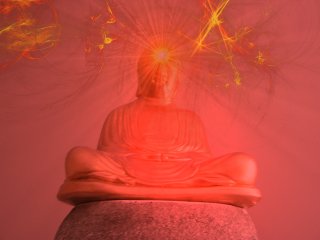Naturally, many Buddhists disagree with the classification of Buddhism as a sect of Hinduism and consider Buddhism to be a separate religion. A part of the problem stems from the rather ambiguous definition of the word "Hindu". The religious beliefs and practices that were prevalent in India in the Buddha's time are not quite the same as those of Hindus today. There are certainly many continuities, but Hinduism has also been shaped since the Buddha's time by interactions with, and responses to challenges posed by, first Buddhism itself, and later, Islam, Christianity, Communism, and many other religions and philosophies. To draw an analogy, Jesus Christ was a Jew, but no modern form of Judaism resembles the Hellenized Judaism practised in the Roman Empire during Jesus' time. Both Judaism and Christianity have evolved since then, and though Christianity had its beginnings as a Jewish sect, it would be strange today to call Christianity a branch of Judaism or to say that Christians are Jews. Similarly, it is jarring to Buddhists to hear Buddhism being referred to as "a part of Hinduism".
However, the analogy cannot be taken too far. Whereas Judaism has ignored Jesus (or rejected him, if one takes the Christian point of view), Hinduism has assimilated the Buddha into its pantheon by identifying him an avatar of the god Vishnu. This identification was probably done at a relatively late date, since some lists of Vishnu's avatars have Balarama instead of the Buddha. It seems that the Buddha was added to the list of Vishnu's avatars in northern India, where Buddhism was popular, but this did not take place in the south. (I have met Hindus from south India who did not include the Buddha in the list of Vishnu avatars.)
The inclusion of the Buddha as one of Vishnu's avatars is something of a backhanded compliment. According to certain Hindu texts, Vishnu incarnated himself as the Buddha in order to mislead demons and miscreants into rejecting the Vedas, thereby damning themselves. Furthermore, Kalki [कल्कि], the future avatar of Vishnu, is supposed to vanquish the Buddhists when he appears. These stories were probably composed at a time when the Hindu clerics felt threatened by the popularity of Buddhism and sought to undermine it. Needless to say, Buddhists do not accept their authenticity. (I had alluded to the Hindu belief that the Buddha is an avatar of Vishnu in this previous post about plans to make a movie based on the life of the Buddha.)
Buddhism, like Hinduism, is assimilative when it comes to other religions. Whenever Buddhism was introduced into a region, it typically did not eliminate the local gods but rather absorbed them into its pantheon. Thus, Buddhist temples in India and in South East Asian countries heavily influenced by Indian culture typically have shrines dedicated to the Hindu gods. However, these gods have been subjugated to Buddhism. In Buddhist mythology, it is Vishnu who is subservient to the Buddha, rather than the other way around. In the Himalayas and in East Asia, the staggering complexity of the Mahayana pantheon is due to Buddhism's absorption of the mythologies of the cultures it encountered as it traversed the Silk Road from India to China (and on to Korean and Japan). Many of these cultures no longer exist, and the only testament that they once existed is the inclusion of their names or those of their deities in the long lists of beings who paid homage to the Buddha in some sutra or the other.
An example of a Buddhist story about a Hindu god which Hindus would probably find insulting is this tale, from "The Iconography of Nepalese Buddhism" by Min Bahadur Shakya, explaining the origin of the "Hariharihariharivahan Lokeshvara" image:
One day while [Takshaka] was leisurely sun basking in a nearby river, a hungry Garuda saw him there. He alighted down and tried to devour Takshaka. Since Takshaka was the king of Nagas, he had great strength. They began to engage in a ferocious battle. He soon began to drag Garuda into river and intended to kill him. Garuda, finding himself about to be killed, invoked his protector Vishnu who came there immediately to save him. As Vishnu was about to cut off the head of Takshaka with his Sudarsanacakra, i.e., whirling disc, Takshaka, realizing his upcoming defeat, prayed for Avalokiteshvara for his protection. Avalokiteshvara arrived there instantly flying over his lion vehicle. Vishnu was ashamed to find Avalokiteshvara, Lord of compassion in front of him and instantly bowed before him throwing away his Sudrashan Chakra and paid homage.Religious competition must have been especially fierce in Nepal!
Thereafter Takshaka and Garuda too retreated from the battle and joined to the worship of Avalokiteshvara. After that Vishnu offered himself to Avalokiteshvara to be his vehicle. In the mean time, the lion also offered himself to be the vehicle of Garuda, in turn. Nagaraja Takshaka also offered to be the vehicle of the lion. Thus this composite image of Avalokiteshvara on Vishnu, and on Garuda, then on the lion, all then on Takshaka. The original image of this unique Lokeshvara is at Changu Narayan, a hill above Sodhani Tirtha, near Bhaktapur.
In all fairness, Hindus and Buddhists typically respect each others' deities and religious figures. When religions interact, a certain amount of syncretism naturally occurs, as each side tries to interpret the other's beliefs within its own framework. Over time, this may result in the assimilation and absorption of some aspects of one religion by the other. Occasionally, however, people try to play games of religious one-upsmanship, resulting in the Buddha becoming an avatar of Vishnu and Vishnu becoming the mount of Avalokiteśvara Bodhisattva.
南無阿彌陀佛

No comments:
Post a Comment